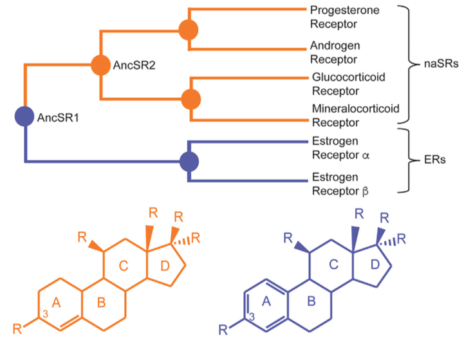When thinking about the evolution of female and male, consider that the first steroid receptor proteins, which emerged about 550 million years ago, were responsive to estrogen. The ancestor of other steroid hormone receptors, responsive to hormones such as testosterone, progesterone and cortisol, emerged many millions of years later.

Blue = estrogen-responsive receptors, Orange = non-aromatized (progesterone, testosterone, cortisol) hormone-responsive
Biochemist Eric Ortlund and colleagues have a new paper in Structure that reconstructs how interactions of steroid receptor proteins evolved over time. This is a complex area to model, since the receptors change shape when they bind their respective hormones, allowing them to bring in other proteins and activate genes.
First author C. Denise Okafor, a FIRST postdoctoral fellow at Emory, will be starting a position as assistant professor at Penn State next month.
The scientists also show that a mutation in the mineralocorticoid receptor associated with severe hypertension (S810L), which makes the receptor more promiscuous, restores an ancestral interaction within the protein.
“Evolutionary substitutions rewired the networks, subsequently altering hormonal interactions and allowing steroid receptors to achieve ligand specificity over time,” the authors write.




